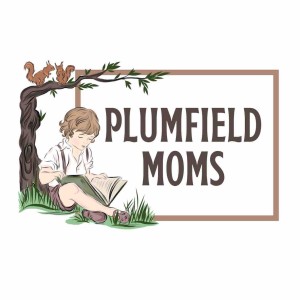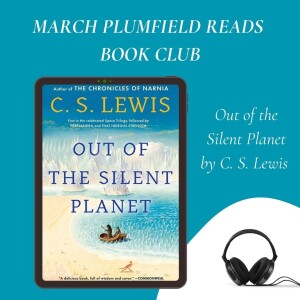Plumfield Moms
We are sisters in Christ who became friends over a shared love of Truth, Goodness, and Beauty, found especially in good and great books. Our primary vocation is that of marriage and motherhood, but we feel a secondary call, as educators and homeschool moms, to walk with families who are seeking to help form souls who are capable of responding to the vocation God has called them to. Our objective is to form our children and grandchildren to the best of our ability, and in so doing share what has been meaningful to us with others that it may encourage them and lighten their burden. As homeschoolers, classical educators and Christians, we have a passion for the ancient Greek paideia and the loving education of Louisa May Alcott‘s Plumfield (from her novel Little Men).
Episodes

Wednesday Apr 03, 2024
Wednesday Apr 03, 2024
Twelfth Night by William Shakespeare (The Bruce Coville retelling is out of print.)
The Taming of the Shrew by William Shakespeare
The Tempest by William Shakespeare
Shakespeare Story Book: Folk Tales that Inspired the Bard by Patrick Ryan
Let's Play Math by Denise Gaskins
A Long Road on a Short Day by Gary D. Schmidt
Gary D. Schmidt
Saturday by Oge Mora
Raccoons are the Brightest People by Sterling North
The Call of the Wild by Jack London
White Fang by Jack London
Wundersmith: The Calling of Morrigan Crow by Jessica Townsend
Ivanhoe by Sir Walter Scott
The Mark of the Thief Trilogy by Jennifer A. Nielsen
Ben-Hur by Lew Wallace
The Importance of Being Earnest by Oscar Wilde
The Aunt and Amabel by Edith Nesbit
The Shakespeare Stealer by Gary Blackwood
Rascal by Sterling North
To Kill a Mockingbird by Harper Lee
Little Britches by Ralph Moody
Lad: The Story of a Dog by Albert Payson Terhune
Gene Stratton-Porter
Armadale by Wilkie Collins
Aurora Floyd by Mary Elizabeth Braddon
The Mayor's Wife by Anna Katherine Green
The Virginian by Owen Wister
One Hundred and One Dalmatians by Dodie Smith
Lorna Doone by R. D. Blackmore
Labors of Hercules Beal by Gary D. Schmidt

Monday Apr 01, 2024
Monday Apr 01, 2024
Despite being an English major at Hillsdale College, I had never read Frankenstein. Truthfully, I had always avoided it. I thought it was just a gothic novel, like Jane Austen’s Northanger Abbey, and I hated that book. I also hated Emily Bronte’s Wuthering Heights and Charles Dickens’ Great Expectations. I just do not care for ghost stories or creepy stories of any kind. I can read Flannery O’Connor and beg for more, but not creepy stories about ghosts or monsters.
This is not a story about a monster. Or at least not the kind of monster I was anticipating. There is no brainless creature terrorizing the countryside. The “Monster” was a created being with human thought and reasoning, emotion, and the capacity for ethics. But, the real monster in this novel is Dr. Frankenstein himself who created this being and then cruelly abandoned him. It is a riveting tale of the human condition.
https://plumfieldandpaideia.com/frankenstein/

Saturday Mar 30, 2024
Saturday Mar 30, 2024
"Once they had seen that what the angel said was true, they were to go quickly and tell his disciples that Jesus was alive. They joyfully ran to do just that. I imagine their faces looked like my little sister’s when she saw the piles of gifts. How long was it before they could stop grinning?
"These women obediently told Jesus’s disciples that Jesus had risen from the dead. His disciples told others, and those others told more, and on and on until someone told ME! What about you? Will you come and see?"

Wednesday Mar 27, 2024
Wednesday Mar 27, 2024
Books and Links:
Plumfield Reads Page
Out of the Silent Planet by C. S. Lewis
Perelandra by C. S. Lewis
That Hideous Strength by C. S. Lewis
The Chronicles of Narnia by C. S. Lewis
Screwtape Letters C. S. Lewis
Mere Christianity C. S. Lewis
The Great Divorce C. S. Lewis
The Man Who Was Thursday by G. K. Chesterton
The Dark Tower by C. S. Lewis (Lewis is the generally accepted author, but not always)
The Hobbit by J.R.R. Tolkien
Father Brown Mysteries by G. K. Chesterton
Lark Rise to Candelford by Flora Thompson
The Abolition of Man by C. S. Lewis
The Keeper of the Bees by Gene Stratton-Porter
The Keeper of the Bees Book Club
Enchantress from the Stars Book Club
Enchantress from the Stars by Silvia Engdahl
Ashtown Burials by N. D. Wilson
A Wrinkle in Time by Madeline L’Engle
The Great Courses
The Great Books of the Western World
The Medieval Mind of C. S. Lewis by Jason M. Baxter
Pretty Copies of Out of the Silent Planet
C. S. Lewis at War C. S. Lewis and Paul McCusker
Learn More About the ladies of Biblioguides
Where You Can Find Us:
Plumfield and Paideia Facebook Page
Plumfield Reads Book Club Discussion Space at the FREE Biblioguides Online Community
Plumfield Moms Podcast Page
Plumfield Moms Instagram

Monday Mar 25, 2024
Monday Mar 25, 2024
Wow! What a story! I would have been impressed if The Stout-Hearted Seven had been fiction. To know that it is non-fiction is exhilarating and tragic all at the same time. Reading true stories like this makes things like Marvel movies seem ridiculous. True courage and fortitude are not found in superheroes with capes but in stout-hearted people with a will to follow God’s leading and their own conviction.
I read the Sterling Point reprint of the original text written by Neta Lohnes Frazier. Frazier opens this memoir by explaining her personal relationship with two of the Sager sisters and pointing to her sources which were mostly primary source material. She explains that she has added dialogue but that even that is based on research and reasonable deduction. After she sets the stage, she begins at the beginning and tells the entire ordeal in the voice of an omniscient narrator. This book reads like an excellent Landmark Book or Messner Biography. It is easy to see why Sterling Books reprinted this one alongside the many Landmark reprints that they did. This is absolutely worth reading. And the audiobook is excellent. https://plumfieldmoms.com/plumfield-moms-book-reviews/the-stout-hearted-seven-orphaned-on-the-oregon-trail

Saturday Mar 23, 2024
Saturday Mar 23, 2024
At the moment Jesus yielded up his spirit, onlookers were mocking him. The land had been in darkness for three hours in the middle of the day. At the moment of Jesus' death, the veil in the temple was torn in two and there was a rock-splitting earthquake. Tombs were opened and dead saints came out of them after Jesus’ resurrection. Events were so startling that even the pagan Roman soldiers on guard said, “Truly this was the Son of God!”
When Jesus’ disciples realized he had really died, they must have believed they had come to the end of the path to glory they had thought they were following with him. Though they didn’t understand what was coming, they had to have been thinking, “Well, this changes everything.” Not for good but for evil.

Monday Mar 18, 2024
Monday Mar 18, 2024
This book is an exquisite introduction to the world-changing advent of machine-printed books. It would also be an excellent starting point for a discussion with older children. Every invention that has been hailed as progress by many has also been met with dire warnings by some. Ancient philosophers cautioned that writing would be the ruin of man’s memory, and in some ways, that has proven true.
https://plumfieldmoms.com/plumfield-moms-picture-book-reviews/from-the-good-mountain-how-gutenberg-changed-the-world

Sunday Mar 17, 2024
Sunday Mar 17, 2024
Living Book Press
Charlotte Mason
Charlotte Mason AudioBooks
Howard Pyle Collection
Microbe Hunters by Paul de Kruif
Railway Children by Edith Nesbit
America’s Children Books by James Otis
Hannah of Kentucky by James Otis
How the Heather Looks Audiobook
Let’s Explore the British Isles
First Books
Purple House Press
Little Britches Series by Ralph Moody
The Mistmantle Chronicles by M. I. McAllister
David Weitzman
Stephen Meader
Glen Blough
Wyatt Blassingame
Combat Nurses of World War II by Wyatt Blassingame
The U.S. Frogmen of World War II by Wyatt Blassingame
Medical Corps Heroes of World War II by Wyatt Blassingame
Microbe Hunters by Paul de Kruif
Evelyn Sibly Lampman
Shy Stegosaurus of Cricket Creek by Evelyn Sibly Lampman
Shy Stegosaurus of Indian Springs by Evelyn Sibly Lampman
Elizabeth Ripley Artist Biographies
Purple House Press Nature Study Library
Jeanne Bendick
Smidgen Press
Charlotte Mason Centenary Edition
Little Men by Louisa May Alcott
Louisa May Alcott
L. M. Montgomery Christmas Collection by L. M. Montgomery
The Daisy Chain by Charlotte Mary Yonge
Frankenstein by Mary Shelly
General
Plumfield Reads Guides
I am David (North to Freedom) by Ann Holm

Saturday Mar 16, 2024
Saturday Mar 16, 2024
Peter says said our inheritance is being kept in heaven for us. Our salvation is ready to be revealed in the last time. When is that last time? No one knows. It will come like a thief in the night. Be ready.

Tuesday Mar 12, 2024
Tuesday Mar 12, 2024
Join us for the March episode of Our Librarian Life. In addition to Kristi and Sherry, this month we are joined by Sarah Kim and Tanya Arnold to talk about what Biblioguides is and how we use it as librarians.
Biblioguides.com
LibraryThing
TinyCat – librarycat.org
Honey for a Child’s Heart by Gladys Hunt
Jan Bloom’s Who Should We Then Read Volumes I and II
I am David (North to Freedom) by Ann Holm
Biblioguides Partner Guides
Picture Book Preschool
The Little Girl with Seven Names by Mabel Leigh Hunt
Ted and Nina books by Marguerite de Angeli
Biblioguides Online Community
Private Lending Library Directory
Find us at The Card Catalog: https://thecardcataloglibrarians.com/








